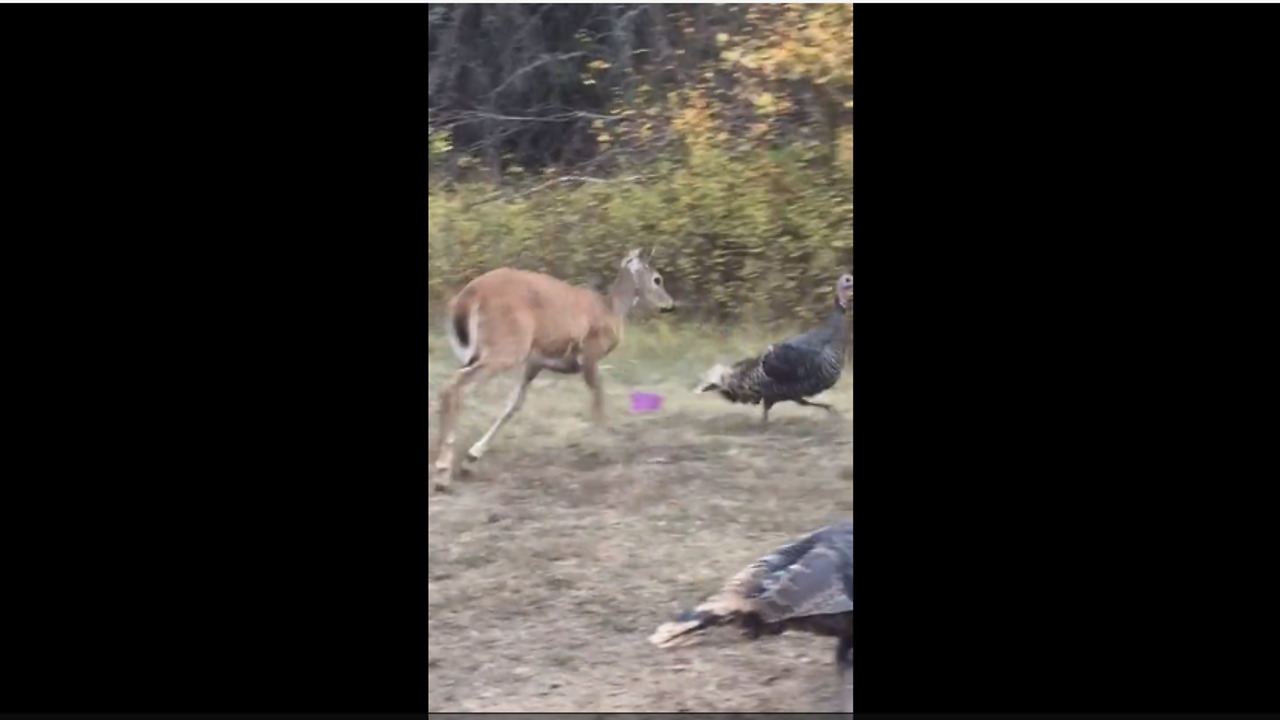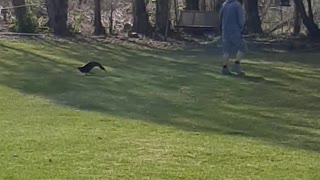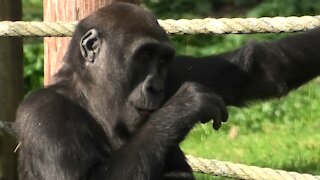Premium Only Content

Protective Fawn Chases Away Intruding Turkeys
We’ve all been there. You’re out on a picnic with mom and dad and your little brother or sister, and then some turkeys crash your party! You try to be polite and ignore the interlopers, but then they double dip the oats and, that’s it! You can’t pretend this is not happening any longer!
“You, turkey, where are your manners? Who invited you, anyway?”
The turkeys are only emboldened by your outrage, however, and when one lets you chase it out of range, another closes in to pick up the morsels the first one dropped. All things considered, it looks like these two vastly different kinds of animals get along pretty well in the same space. Turkeys are omnivorous, and will eat grains, fruits, and small insects, even lizards or amphibians, while deer are strictly ruminants. What’s a ruminant? Well, even though deer eat in grassy areas, they don’t eat the same things as, let’s say, cows. When you see them chewing close to the ground, they are really eating things like lichen and small leafy plants, but not grass. It doesn’t appear to be a problem here, but deer are also notorious for raiding gardens. They will eat the tops off of turnips and radishes, corn, and even dig for carrots.
Gardeners find turkeys beneficial, because the flock of turkeys will move through a garden like an insect devouring machine. The human taking the video is congratulating the deer for chasing the turkey out of the yard. She’s taking sides, but we don’t know what she has against turkeys. Over the past four decades, turkey populations went from nearly extinct to burgeoning. They are now one of the most ubiquitous fauna of rural landscapes, not surprisingly equal to the herds of deer. Both have managed an impressive comeback, and both manage to coexist surprisingly well alongside human habitats.
These two creatures, one a mammal and the other an avian, don’t seem to regard each other too suspiciously. We can imagine other pairings would be impossible, such as deer or turkey with coyotes, bobcats, wolves, foxes, or other predators. But there’s nothing especially predatorial about deer or turkeys, and the one isn’t really out to make a meal of the other, so the conflict doesn’t go beyond a short chase scene.
If it is the fall season, both species are trying to fatten up before winter. Neither deer nor turkey hibernate or migrate. Both stand their ground in winter, and both have ways of negotiating the harsh snow and cold that ensues. Deer fur thickens, and they will dig deep under the snow for shrubs and berries, or eat tender new shoots and buds, especially late in winter. Turkeys can ruffle their large feathers and trap warmth close to their skin. Many farmers may not admit it, but large mounds of commercial bird feed mysteriously appear on driveways, where turkeys can be seen corralling around garages and front yards. They are just so darned interesting, who can resist helping them out from time to time?
-
 3:04
3:04
Timeless Aerial Photography
4 years agoAngry turkeys chase down truck to attack it
3.49K17 -
 0:14
0:14
ViralHog
4 years ago $1.39 earnedMoose Chases Playful Dog around Trees
5.24K2 -
 1:02
1:02
NataliaCara
4 years agoRescued baby manatee chases tasty banana around enclosure
5.73K20 -
 0:34
0:34
WildCreatures
4 years ago $12.72 earnedBaby elephant chases keeper to demand his watermelons
10.3K15 -
 0:36
0:36
ViralHog
4 years ago $0.48 earnedWombat Chases Canine Friend
3.67K2 -
 1:06
1:06
MaxandKatietheGreatDanes
4 years ago $22.29 earnedPlayful cat chases bouncing Great Dane
16.7K6 -
 0:59
0:59
Snowfrickenwhite
4 years ago $16.77 earnedDeer and turkeys gather together in backyard for treats
3.87K10 -
 0:50
0:50
ViralHog
5 years ago $0.89 earnedDuck Chases Owner, Then Acts Casual
13.1K1 -
 1:30
1:30
SloggerVloggerGorillas
4 years agoGorilla youngster chases rabbit around his enclosure
12.7K4 -
 2:14
2:14
Deer In Nature
4 years ago $4.72 earnedMother deer & fawn surprisingly calm around humans
5.24K26